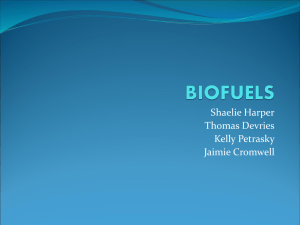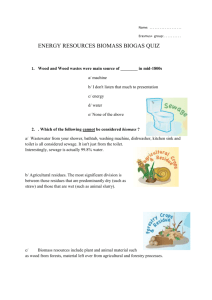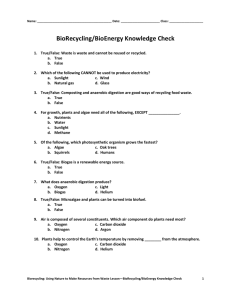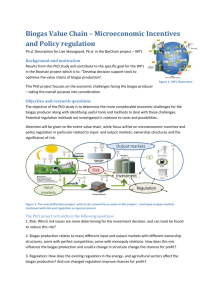The theory, operation and current status of
advertisement
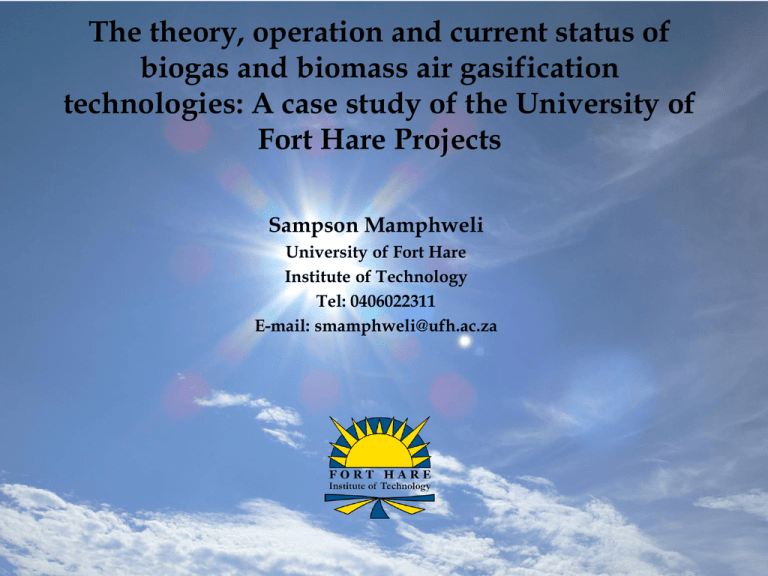
The theory, operation and current status of biogas and biomass air gasification technologies: A case study of the University of Fort Hare Projects Sampson Mamphweli University of Fort Hare Institute of Technology Tel: 0406022311 E-mail: smamphweli@ufh.ac.za OVERVIEW OF RESEARCH AT FHIT 2 Biogas digester types • Biogas produced in anaerobic digesters consists of methane (50-80%), carbon dioxide (20-50%) and trace levels of other gases such as hydrogen, carbon monoxide, nitrogen, oxygen and hydrogen sulphide. • Anaerobic digesters are made out of concrete, steel, bricks or plastic. They are shaped such as troughs, basins or ponds, and may be placed underground or on the surface depending on the design and climatic conditions of an area. • There are two basic types of digesters, which are batch type and continuous type. • There are three types of continuous digesters, these are: Vertical tank systems, horizontal tank or plug-flow systems and multi tank systems. 3 The digestion process • Anaerobic decomposition occurs in three basic stages as a result of the activity of a variety of microorganisms. Initially, a group of microorganisms converts organic material into a form that a second group of organisms utilizes to form organic acids and complete the decomposition process. • A number of factors affect the rate of digestion and biogas production. The most important is temperature. • Anaerobic bacteria communities can endure temperatures ranging from below freezing to above 57 oC, but they thrive best at temperatures of about 37oC (mesophillic bacteria) and 55oC (thermophillic bacteria). • Bacteria activity, and thus biogas production, falls off significantly between 39oC and 51oC and gradually from 35oC to 0oC. 4 The digestion process • • • • Hydrolysis is an enzyme mediated stage where insoluble organic compounds such as proteins, fats, lipids and carbohydrates are converted into soluble organic components such as amino acids, fatty acids, monosaccharides, and other simple organic compounds. Acidogenesis or fermentation is the next step where soluble compounds produced in the first stage are further degraded resulting in the production of carbon dioxide (CO2), hydrogen (H2), organic acids, alcohols and some organic sulphur compounds. Acetogenesis is the third stage of acetic acid formation (acetogenesis) combines the prior acidification with methane formation. The starting substrates are a number of final products from the acidification phase. Examples include, chain fatty acids, propionic acid, polymer substrates (carbohydrates, fats, proteins) and butyric acid. Together with lactic acid, alcohols and glycerol, these substrates are converted by the acetogenic micro-organisms into acetic acid, hydrogen and carbon dioxide Methanogenesis: Methanogens convert the acetate and hydrogen to methane and carbon dioxide. Methanogenic bacteria are divided into three categories. Hydrogenotrophic methanogens use hydrogen to convert carbon dioxide to methane. Acetotrophic methanogens split acetate into methane and carbon dioxide. Finally, methylotrophic methanogens produce methane directly from methyl groups, such as methanol, and mono-, di-, and trimethylamines. 5 The digestion process 1. STEP Hydrolysis macromolecule (Hydrolytic phase) 2. STEP 3. STEP Acetic acid formed (Acetogene phase) Acidification (Acidogene phase) pH: 5.5-6.7 pH: 5-6 4. STEP Methane formation (Methanogene phase) pH: 6.6-8.0 Hydrogen Carbon dioxide Biomass Carbohydrates Proteins Fats Biogas Methane Carbon dioxide Sugars Amino acids Fatty acids Fatty acids (Propionic acid) Alcohols Acetic acid Hydrogen Carbon dioxide 6 Energy from biogas • Approximately 1.15 kg of organic waste provides 1 m3 of biogas, equivalent of 1.7 kWh of energy. • The energy can be used for direct heating or power generation purposes. 7 Biogas digesters installations at UFH The research is focused on: – Design, installation and performance monitoring of biogas digesters. – 5 biogas digesters installed at Fort Cox college, Melani village and UFH. – 110 digesters planned for Nkonkobe municipality-implementation imminent. – At least 4 digesters planned for schools in Chris Hani District Municipality – Demonstrate the use of biogas technology as a cheap and sustainable option. 8 Biogas digesters research activities • Design, installation and performance monitoring Data logger Sensor output COMPUTER Temperature probes 1 and 2 Gas sensors Gas to house Flow meter Inlet pipe Reinforced Concrete dome Temperature probe 2 BIOGAS Inner Brick wall Brick wall SLURRY Sawdust Stirrer 30 cm blade Temperature probe1 Slurry outlet Digester floor 106 cm 20 cm 20 cm Concrete slab 9 Biogas digesters research activities • Design, installation and performance monitoring H2S sensor Flow meter Biogas hose Laptop Hydrophobic filter Gas pump 12V battery CO2 sensor H2 sensor Data logger CH4 sensor 10 Biogas digesters research activities • Biogas yield from cowdung before digester insulation 0.35 0.3 Gas yield / m3 0.25 y = 0.002x2 - 0.0199x + 0.0356 R² = 0.9489 0.2 0.15 0.1 0.05 0 2 4 6 8 10 12 Time / days 14 16 18 20 11 Biogas digesters research activities • Biogas yield from cow dung vs COD concentration 0.6 45000 40000 0.5 Gas yield 35000 0.4 30000 25000 pH Biogas yield / m3 COD 0.3 20000 0.2 15000 10000 0.1 5000 0 0 1 3 5 7 9 11 13 15 17 19 21 23 25 27 29 Retention time / days 12 Biogas digesters research activities • Biogas yield from cow dung and donkey dung 0.6 Biogas yield / m3 0.5 0.4 Cow Donkey 0.3 0.2 0.1 0 4 6 8 10 12 14 16 18 Retention time / days 20 22 24 26 28 30 13 Biogas digesters research activities • Bacteria activity in cowdung – Bacteria that has been well documented in cow manure include Salmonella Sp, Escherichia coli and Camphilobacter species. – These are associated with human gastrointestinal infection. 14 (a) Reduction of Campylobacter sp counts with retention time. (b) Reduction of E. coli counts with retention time. (c) Reduction of Salmonella sp counts with retention time. 4.5 6 6 measured data regression line 4 measured data regression line measured data regression line 5 5 3 2.5 2 1.5 log bacteria counts(cfu/g) log bacteria counts (cfu/g) log bacteria counts (cfu/g) 3.5 4 3 2 4 3 2 1 1 1 0.5 0 0 5 10 15 Time/Days (a) 20 0 0 20 40 60 Time/Days (b) 80 0 0 25 50 75 100 125 150 Time/Days (c) 15 Digesters at UFH 16 BIOMASS GASIFICATION • Biomass gasifier converts wood and wood waste into charcoal giving gas as a by-product. • The gas is a mixture of CO2, CH4, H2, CO, H2O and N2. • It has a heating value of 3-6MJ/kg and is used for heating and electricity generation. • The University of Fort Hare installed a150kVA System Johanson Biomass Gasifier at Melani village for powering a community bakery and for research purposes. 17 Gasification process Drying Biomass + H2O H2O Pyrolysis N2,Tar,CH4 Oxidation CO,H2O Reduction CO2,H2 Producer gas 18 THE PROCESS The Gas Producer The pollution-free answer to providing inexpensive energy through consumption of Bio-mass material! Gasifier 1.Fuel Compartment with Condensate trap 2.Inverted Reduction Cone 3. Combustion Chamber 4.Hearth 5. Ash Grate Activator The Cyclone The Raw Gas is passed through the Cyclone, which removes the course dust from the raw gas The Gas Scrubber / Cooler. After the course dust has been removed from the cyclone, the fine dust(5ml/N³) is carried with the sprayed scrubbing water over a low resistance porous scrubbing media. The water is recycled through an ambient cooling pond. The gas is cooled to ambient temp. The long life particle interference filter…. The Particle Interference Filter The cooled gas is passed through the filter filled with course sawdust The safety filter…. The Safety Filter Before reaching the engine, the clean gas is finally passed through a standard 5 micron double cartridge Donaldson Filter. The generator…. The Generator……. The engine…. The Engine…… The engine…. (CO) Emissions from Engine Carbon neutral The cooling pond…. The Cooling Pond…… Water contains no toxic elements and can be used for irrigation purposes! Prototype for R&D 29 BIOMASS CHARACTERIZATION 30 • 150 kVA Melani village gasifier 31 The gasifier 32 Presented by: Sampson Mamphweli Thank you 33
